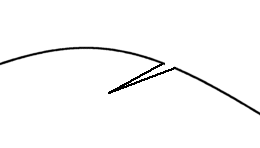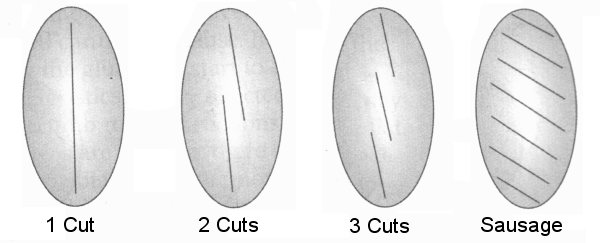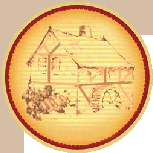by Les Saidel - December, 2011
As little as 300 years ago in Europe, bread baking was a communal activity. Only the very wealthy could afford to construct their own private brick ovens in spacious estate kitchens. The simple folk, being mostly poor, could not afford such luxuries. As a result, large central communal ovens were constructed that served the entire village or community, financed either by a magnanimous aristocrat or by the pooling of the meagre individual resources.
Each housewife prepared her own dough at home and then took it to the communal oven to bake. Depending on the size and population of the village, baking was scheduled on different days of the week and each family was allotted a specific day and time to use the oven.
Understandably, with many people using the same oven simultaneously, confusion was very common and in order to identify which loaf belonged to whom, each family made their own markings on the loaf, by cutting a pattern or initial into the crust. This was the origin of the technique known as "scoring" or cutting slits in the crust of the dough.
Scoring developed into something of an art form and the aristocracy enjoyed highly attractive calligraphy on their breads, with insignia, initials etc. Nowhere was this phenomenon more prevalent than in France. Many classic French loaves owe their characteristic appearance to the patterns that were "scored" (or cut) into the loaves. The most well known of course is the baguette, with its parallel diagonal scoring pattern in the crust.
Aside from simply looking good however, scoring has an additional purpose. This was not the original intention of scoring when it was invented, but evolved as professional bakers experimented and observed the effects of different scoring patterns and how they manifested in the final baked product. Eventually scoring became an additional tool in the baker's arsenal which allowed him to gain further control over the appearance of his loaf.
All bread rises in the oven while it is baked. If a bread is not scored, the way it rises is highly dependent on how it was shaped and baked.
If you are a very proficient baker and so adept at shaping your loaf so that it has an almost uniform tension over the entire exposed surface, then the loaf will rise uniformly in all directions when it is baked. If however, some parts are less tightly stretched than others, they will bulge more and the resulting bread will look something like a drunk camel (with many humps).
Even more severe is if the crust of the bread dries out before the inner crumb has fully risen. In this case the bread has no possibility to further expand as it is "trapped" by the dry outer crust. What usually happens in this case is that the bread bursts through the crust randomly (usually at the weakest spot) and the resulting appearance is not attractive.
Scoring helps to lessen the above phenomena (it does not eliminate them entirely as there are other factors involved), but it definitely increases the baker's control over the final appearance of his loaf.
The science is very simple. The assumption is that the outer crust is less moist (drier) than the dough beneath. This is amplified as the bread begins to bake and the first part of the bread to dry out is the outer crust. If however, immediately prior to baking you score the bread, you thereby expose the moister, inner dough. When the bread is then baked, the outer crust will dry at a quicker rate than the exposed, moister inner dough. This exposed inner dough will have more time to rise and expand before itself drying out as the baking proceeds and will therefore allow the entire loaf to rise fully without bursting through a completely dried crust.
What happens in fact is that when you score a loaf by cutting a slit into the dough, that slit expands during the bake, allowing the entire loaf to fully rise and also creating an attractive pattern on the crust of the loaf.
By altering the orientation of the scoring and the density (distance from one cut to another), you control which direction the bread will rise in. Using this technique you can accentuate the appearance of your loaf, for example more outwardly expanding, more vertically expanding, lengthways, sideways, etc.
To score your loaves you will need one simple tool - a razor blade. Not the kind where the blade is inseparably attached to a plastic handle for shaving, but simply the paper-thin metal blade itself. Aside from a surgeon's scalpel, this is the sharpest utensil available to the home baker and the cheapest.
Professional bakers use a stainless steel metal handle called a "lame" (pronounced la-meh) onto which the razor blade is attached by slightly bending the blade, forming a curved cutting edge. However similar results are obtainable with the blade itself without the lame. You will need to be more cautious when handling the pure blade as it is VERY sharp.
Scoring involves making incisions into the dough. The correct incision is not vertical but angled at 45 degrees to the crust, as follows -

The rule of thumb is - the more the score is oriented parallel to the length of the loaf, the more the loaf will expand sideways. The more the score is at right angles to the length of the loaf, the more it will expand vertically.
For example, a long, thin baguette style loaf is scored almost parallel to the length allowing it to expand sideways (see the 3 Cuts pattern below), thus making it appear "fatter". A weak dough that needs an extra vertical push, such as one made with rye flour for example, is better off with a scoring pattern that is at right angles to the length (see the Sausage pattern below).

Similarly, round shaped loaves may be scored in different patterns that determine the direction and degree of expansion.

The above are only examples of some standard scoring patterns. You may score letters, pictures and almost any other pattern, limited only by your imagination.
TIP: If you are going to score your loaf, it is easier if the crust is a little drier. A sticky, wet crust is difficult (but not impossible) to score as the blade may get stuck and drag the dough along with it. To dry the crust a little (not too much), expose it to the air at about 20 minutes before baking - if your rising dough is covered, uncover it.
The best way to discover how a score pattern affects your loaf is by experimenting. It is a fun activity and a highly creative one too and gives the resulting bread a personal touch that nobody else can duplicate.
Les Saidel
© Copyright. All rights in the above articles are reserved to the author Les Saidel.
No part of this website or the above articles may be transmitted in any form or by any
means without permission in writing from the author.




